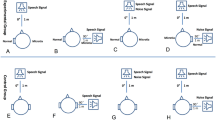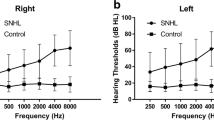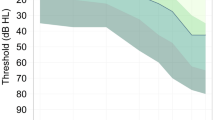Abstract
Background
Cleft lip and palate (CLP) represents the most common malformation of the midfacial region worldwide. It can be suggested that the facial stigmatization, the speech impediment, and the long-standing pressure of treatment cause a range of life stressors. Neurocortical information is influenced by physiological and psychological factors and varies significantly in patients suffering from chronic stress, anxiety, depression, or other psychopathological conditions following maladaptation. The aims of the present study were to investigate the neurocortical information processing of patients with CLP using the contingent negative variation (CNV) paradigm and to evaluate secondary psychopathology, anxiety, and depression.
Materials and methods
Twenty-five adults with CLP and 25 healthy volunteers, matched in age and gender, were investigated using recordings of the CNV. Initial CNV (iCNV), late CNV (lCNV), and total CNV (tCNV) as well as habituation slope of the iCNV were determined in each subject. Additionally, each participant had to complete the hospital anxiety and depression questionnaire (HADS) and the Symptom Checklist-90-R (SCL-90-R).
Results
Individuals with CLP did not differ significantly from healthy subjects according to any of the CNV parameters investigated. No correlations could be revealed between the measured items and the confounding factors age and gender. Additionally, there were no differences between the groups regarding depression and SCL-90-R; however, anxiety showed significant group differences on a subclinical level.
Conclusions
These data suggest that subjects with CLP show normal neurocortical information processing. It seems likely that CLP and its treatment have no impact on psychosocial functioning and neurophysiological mechanisms of attention.
Clinical relevance
The specific living conditions of patients with CLP do not result in disease-specific neurophysiological changes.


Similar content being viewed by others
References
Dixon MJ, Marazita ML, Beaty TH, Murray JC (2011) Cleft lip and palate: understanding genetic and environmental influences. Nat Rev Genet 12:167–178. doi:10.1038/nrg2933
Hunt O, Burden D, Hepper P, Stevenson M, Johnston C (2006) Self-reports of psychosocial functioning among children and young adults with cleft lip and palate. Cleft Palate Craniofac J 43:598–605. doi:10.1597/05-080
Gee GC, Payne-Sturges DC (2004) Environmental health disparities: a framework integrating psychosocial and environmental concepts. Environ Health Perspect 112:1645–1653
Fisher M, Baum F (2010) The social determinants of mental health: implications for research and health promotion. Aust NZJ Psychiatry 44:1057–1063. doi:10.3109/00048674.2010.509311
Pinquart M, Shen Y (2011) Depressive symptoms in children and adolescents with chronic physical illness: an updated meta-analysis. J Pediatr Psychol 36:375–384. doi:10.1093/jpepsy/jsq104
Christensen K, Juel K, Herskind AM, Murray JC (2004) Long term follow up study of survival associated with cleft lip and palate at birth. BMJ 328:1405. doi:10.1136/bmj.38106.559120.7C
Birbaumer N, Elbert T, Canavan AG, Rockstroh B (1990) Slow potentials of the cerebral cortex and behavior. Physiol Rev 70:1–41
Johnson R Jr (1986) A triarchic model of P300 amplitude. Psychophysiology 23:367–384
Elbert T (1993) Slow cortical potentials reflect the regulation of cortical excitability. Plenum Press, New York
Bender S, Resch F, Weisbrod M, Oelkers-Ax R (2004) Specific task anticipation versus unspecific orienting reaction during early contingent negative variation. Clin Neurophysiol 115:1836–1845. doi:10.1016/j.clinph.2004.03.023
Siniatchkin M, Gerber WD, Kropp P, Voznesenskaya T, Vein AM (2000) Are the periodic changes of neurophysiological parameters during the pain-free interval in migraine related to abnormal orienting activity? Cephalalgia 20:20–29
Bender S, Weisbrod M, Bornfleth H, Resch F, Oelkers-Ax R (2005) How do children prepare to react? Imaging maturation of motor preparation and stimulus anticipation by late contingent negative variation. Neuroimage 27:737–752. doi:10.1016/j.neuroimage.2005.05.020
Cui RQ, Egkher A, Huter D, Lang W, Lindinger G, Deecke L (2000) High resolution spatiotemporal analysis of the contingent negative variation in simple or complex motor tasks and a non-motor task. Clin Neurophysiol 111:1847–1859
Pribram KH, McGuinness D (1975) Arousal, activation, and effort in the control of attention. Psychol Rev 82:116–149
Rockstroh B, Elbert T, Birbaumer N (1982) Slow brain potentials and behaviour. Urban & Schwarzenberg, Baltimore
Jasper H (1958) The ten-twenty electrode system of the International Federation. Electroencephalogr Clin Neurophysiol 10:371–375
Gratton G, Coles MG, Donchin E (1983) A new method for off-line removal of ocular artifact. Electroencephalogr Clin Neurophysiol 55:468–484
Bocker KB, Timsit-Berthier M, Schoenen J, Brunia CH (1990) Contingent negative variation in migraine. Headache 30:604–609
Kropp P, Gerber WD (1995) Contingent negative variation during migraine attack and interval: evidence for normalization of slow cortical potentials during the attack. Cephalalgia 15:123–128
Kropp P, Gerber WD (1998) Prediction of migraine attacks using a slow cortical potential, the contingent negative variation. Neurosci Lett 257:73–76
Kropp P, Kirbach U, Detlefsen JO, Siniatchkin M, Gerber WD, Stephani U (1999) Slow cortical potentials in migraine: a comparison of adults and children. Cephalalgia 19(Suppl 25):60–64
Kropp P, Siniatchkin M, Stephani U, Gerber WD (1999) Migraine—evidence for a disturbance of cerebral maturation in man? Neurosci Lett 276:181–184
Siniatchkin M, Gerber WD, Kropp P, Vein A (1999) How the brain anticipates an attack: a study of neurophysiological periodicity in migraine. Funct Neurol 14:69–77
Siniatchkin M, Kirsch E, Kropp P, Stephani U, Gerber WD (2000) Slow cortical potentials in migraine families. Cephalalgia 20:881–892
Siniatchkin M, Kropp P, Gerber WD, Stephani U (2000) Migraine in childhood—are periodically occurring migraine attacks related to dynamic changes of cortical information processing? Neurosci Lett 279:1–4
Zigmond AS, Snaith RP (1983) The hospital anxiety and depression scale. Acta Psychiatr Scand 67:361–370
Herrmann C, Buss U (2012) Ein Fragebogen zur Erfassung des psychischen Befindens bei Patienten mit körperlichen Beschwerden. Diagnostica 40:143–154
Derogatis LR (1977) SCL-90-R. Self-report symptom inventory 90 items—revised. Vormals Hopkins symptom check list. Symptom-Check-Liste. Selbst- oder Fremdbeurteilungs-Skala (S/F). Beltz, Weinheim
Oosterkamp BC, Dijkstra PU, Remmelink HJ, van Oort RP, Goorhuis-Brouwer SM, Sandham A, de Bont LG (2007) Satisfaction with treatment outcome in bilateral cleft lip and palate patients. Int J Oral Maxillofac Surg 36:890–895. doi:10.1016/j.ijom.2007.07.008
Tobiasen JM, Hiebert JM (1993) Clefting and psychosocial adjustment. Influence of facial aesthetics. Clin Plast Surg 20:623–631
Meyer-Marcotty P, Gerdes AB, Reuther T, Stellzig-Eisenhauer A, Alpers GW (2010) Persons with cleft lip and palate are looked at differently. J Dent Res 89:400–404. doi:10.1177/0022034509359488
Berger ZE, Dalton LJ (2011) Coping with a cleft II: factors associated with psychosocial adjustment of adolescents with a cleft lip and palate and their parents. Cleft Palate Craniofac J 48:82–90. doi:10.1597/08-094
Hoek IH, Kraaimaat FW, Admiraal RJ, Kuijpers-Jagtman AM, Verhaak CM (2009) Psychosocial adjustment in children with a cleft lip and/or palate. Ned Tijdschr Geneeskd 153:B352
Hunt O, Burden D, Hepper P, Stevenson M, Johnston C (2007) Parent reports of the psychosocial functioning of children with cleft lip and/or palate. Cleft Palate Craniofac J 44:304–311. doi:10.1597/05-205
Noor SN, Musa S (2007) Assessment of patients’ level of satisfaction with cleft treatment using the Cleft Evaluation Profile. Cleft Palate Craniofac J 44:292–303. doi:10.1597/05-151
Gassling V, Holterhus PM, Herbers D, Kulle A, Niederberger U, Hedderich J, Wiltfang J, Gerber WD (2012) Stress-coping and cortisol analysis in patients with non-syndromic cleft lip and palate: an explorative study. PLoS One 7:e41015. doi:10.1371/journal.pone.0041015
Garmezy N (1991) Resilience in children’s adaptation to negative life events and stressed environments. Pediatr Ann 20:459–6
Folkman S (1997) Positive psychological states and coping with severe stress. Soc Sci Med 45:1207–1221
Feragen KB, Borge AI, Rumsey N (2009) Social experience in 10-year-old children born with a cleft: exploring psychosocial resilience. Cleft Palate Craniofac J 46:65–74. doi:10.1597/07-124.1
Roberts RM (2014) Discrimination among adults with craniofacial conditions. J Craniofac Surg 25:77–81. doi:10.1097/SCS.0b013e3182a2e005
Roberts RM, Mathias JL (2012) Psychosocial functioning in adults with congenital craniofacial conditions. Cleft Palate Craniofac J 49:276–285. doi:10.1597/10-143
Roberts RM, Mathias JL (2013) Predictors of mental health in adults with congenital craniofacial conditions attending the Australian craniofacial unit. Cleft Palate Craniofac J 50:414–423. doi:10.1597/11-105
Demir T, Karacetin G, Baghaki S, Aydin Y (2011) Psychiatric assessment of children with nonsyndromic cleft lip and palate. Gen Hosp Psychiatry 33:594–603. doi:10.1016/j.genhosppsych.2011.06.006
Acknowledgments
We thank all participating patients and control subjects for their cooperation. This study was financed by the corresponding author’s institution.
Conflict of interest
The authors declare that they have no conflict of interest.
Author information
Authors and Affiliations
Corresponding author
Additional information
Trial Registration: German Clinical Trials Register (registration code DRKS00004606).
Rights and permissions
About this article
Cite this article
Gassling, V., Receveur, K., Niederberger, U. et al. No deficit in neurocortical information processing in patients with cleft lip and palate. Clin Oral Invest 20, 23–30 (2016). https://doi.org/10.1007/s00784-015-1465-9
Received:
Accepted:
Published:
Issue Date:
DOI: https://doi.org/10.1007/s00784-015-1465-9




